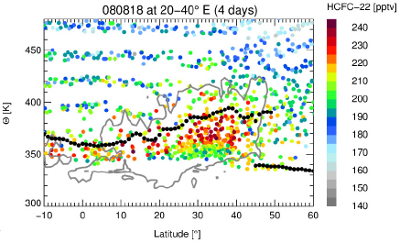MIPAS HCFC-22 measurements help to identify the transport of young air masses to the top of the Asian monsoon anticyclone and into the tropical pipe

Latitude–theta cross section of MIPAS HCFC-22 measurements at 30◦ E (western part of the anticyclone) on 18 August 2008. The MIPAS measurements are synoptically interpolated within 4 days. The grey line provides the contour line of the area where the air inside the Asian monsoon anticyclone comprises to at least 20% or more from air originating at the surface in India or China according to CLaMS model calculations. The thermal tropopause is marked by black dots. Note the layer of enhanced HCFC-22 concentrations just below the tropopause.
With anthropogenic production concentrated in continental East Asia, HCFC-22 is a good tracer for identifying the transport of air masses and pollution into the Asian monsoon anticyclone and the propagation into the stratosphere from there. CLaMS model calculations with idealized tracers released in the India and China area are compared with MIPAS HCFC-22 observations. The idealized tracers and HCFC-22 from MIPAS agree in the horizontal distribution, in the accumulation below and slightly above the Asian monsoon tropopause, and in their further pathway into the middle stratosphere via transport to low latitudes and uplift in the tropical pipe. According to our study, the transport of air masses from boundary layer sources in the region of the Asian monsoon into the tropical pipe occurs in three distinct steps. First, very fast uplift in “a convective range” transports air masses up to 360 K potential temperature within a few days. Second, air masses are uplifted from about 360 K up to 460 K within “an upward spiralling range” within a few months. The large-scale upward spiral extends from northern Africa to the western Pacific. The air masses are transported upwards by diabatic heating with a rate of up to 1–1.5 K per day, implying strong vertical transport above the Asian monsoon anticyclone. Third, transport of air masses occurs within the tropical pipe up to 550 K associated with the large-scale Brewer–Dobson circulation within ∼ 1 year. In the upward spiralling range, air masses are uplifted by diabatic heating across the (lapse rate) tropopause, which does not act as a transport barrier, in contrast to the extra-tropical tropopause. During step 2 and 3, mixing with air not previously confined to the Asian monsoon anticyclone happens.
For more information see: https://doi.org/10.5194/acp-19-6007-2019
